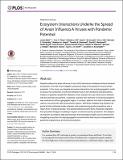Ecosystem Interactions Underlie the Spread of Avian Influenza A Viruses with Pandemic Potential
Author(s)
Bahl, Justin; Pham, Truc T.; Easterday, Bernard C.; Halpin, Rebecca A.; Stockwell, Timothy B.; Wentworth, David E.; Kayali, Ghazi; Krauss, Scott; Schultz-Cherry, Stacey; Webster, Robert G.; Webby, Richard J.; Swartz, Michael D.; Smith, Gavin J. D.; Hill, Nichola; Hussein, Islam; Ma, Eric Jinglong; Runstadler, Jonathan; ... Show more Show less
Downloadjournal.ppat.1005620.PDF (1.993Mb)
PUBLISHER_CC
Publisher with Creative Commons License
Creative Commons Attribution
Terms of use
Metadata
Show full item recordAbstract
Despite evidence for avian influenza A virus (AIV) transmission between wild and domestic ecosystems, the roles of bird migration and poultry trade in the spread of viruses remain enigmatic. In this study, we integrate ecosystem interactions into a phylogeographic model to assess the contribution of wild and domestic hosts to AIV distribution and persistence. Analysis of globally sampled AIV datasets shows frequent two-way transmission between wild and domestic ecosystems. In general, viral flow from domestic to wild bird populations was restricted to within a geographic region. In contrast, spillover from wild to domestic populations occurred both within and between regions. Wild birds mediated long-distance dispersal at intercontinental scales whereas viral spread among poultry populations was a major driver of regional spread. Viral spread between poultry flocks frequently originated from persistent lineages circulating in regions of intensive poultry production. Our analysis of long-term surveillance data demonstrates that meaningful insights can be inferred from integrating ecosystem into phylogeographic reconstructions that may be consequential for pandemic preparedness and livestock protection.
Date issued
2016-05Department
Massachusetts Institute of Technology. Department of Biological Engineering; Massachusetts Institute of Technology. Division of Comparative MedicineJournal
PLOS Pathogens
Publisher
Public Library of Science
Citation
Bahl, Justin, Truc T. Pham, Nichola J. Hill, Islam T. M. Hussein, Eric J. Ma, Bernard C. Easterday, Rebecca A. Halpin, et al. “Ecosystem Interactions Underlie the Spread of Avian Influenza A Viruses with Pandemic Potential.” Edited by Neil M. Ferguson. PLOS Pathogens 12, no. 5 (May 11, 2016): e1005620.
Version: Final published version
ISSN
1553-7374